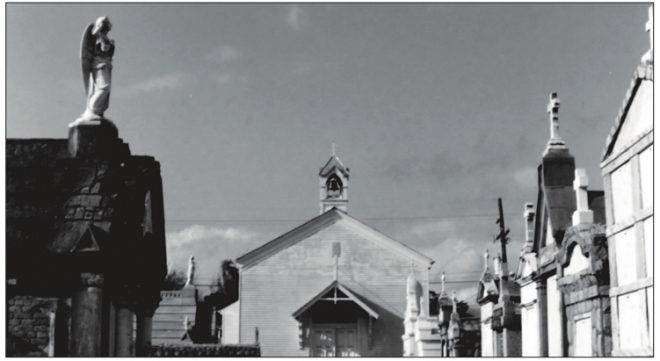CEMETARY STATUES

I was driving some friends of mine, who are not from here, and showing them the sights. They are interested in cemeteries, and I took them to Greenwood and Oakland. They were amazed by the different types of monuments and all of the artwork on them. Can you tell us about what some of these mean?
Cemeteries, particularly those with origins in the nineteenth century or earlier, are laboratories for historians, genealogists, preservationists and others interested in the changing dynamics of society. Tombstones, sepulchers, mausoleums and cenotaphs (which are funerary structures with no body) all yield basic information about the person they memorialize, but many contain intricate artwork that expands the stories of the deceased, their beliefs or affiliations. Some are light-hearted and humorous, some are whimsical, and others are very serious.
When viewing older tombs you will note some common themes. Angels in various shapes, sizes and forms are abundant. Classical statues, usually female, denote the tombs of young women. A spreading willow tree symbolizes the tree of life. An hour glass is the very real reminder that life is fleeting. Laurel wreaths signify eternity and purity. A lamb usually indicates the grave of a child. Conversely, a sheaf of wheat often marks the tomb of someone who has lived a long life. The Madonna or Easter Lily is the symbol of purity and Morning Glories are a symbol of the Resurrection.
Tall thin monuments usually denote one of two styles. A rectangular shaft with a pyramid at the top is an obelisk. It will resemble the Washington Monument. This type is an Egyptian Revival. Archaeology was in its infancy when these became popular. The other form also has classical origins. It has a flat top and may be draped or have a devise on top of it. This is a column. It is reminiscent of Greek and Roman construction.
Some symbols are more difficult to divine. An anchor does not necessarily mean the person entombed was a sailor. Instead, it is the symbol of eternal hope. A cross placed at an angle within a crown is a Christian symbol for the sovereignty of the Lord. It can also be a Masonic emblem. A hand portrayed with the index finger pointing up and the other fingers curled almost shouts “I know where I am going. Do you?” The reverse, a hand descending from a cloud, index finger pointing down and sometimes with links of a broken chain signifies the hand of God plucking a soul from the bonds of earth. A skull with wings attached to it can either signify the Holy Ghost, the soul waiting to rise to Heaven, or simply “Here lies the remains of” an individual. The latter is a Puritan device. Double tombs sometimes share images of two people shaking hands. Most of these show the hand on the viewers’ left as a man’s hand, often with a French-cuffed sleeve. The hand on the right often has lace. This is an indication that the couple was married and is joined in death.
Benevolent societies, insurance cooperatives and fraternal organizations used symbolic devices to adorn members’ tombs. The most common of these in our region relates to the timber industry. Most of our older cemeteries contain oddly configured tombstones that resemble tree trunks or stacked logs. These tree stones, as they are called, may have the letters WOW on them or an ornate seal. This signifies that the person was a member of Woodmen of the World, a combination benevolent association and insurance company. Other societies have their own mystical symbols as well.
